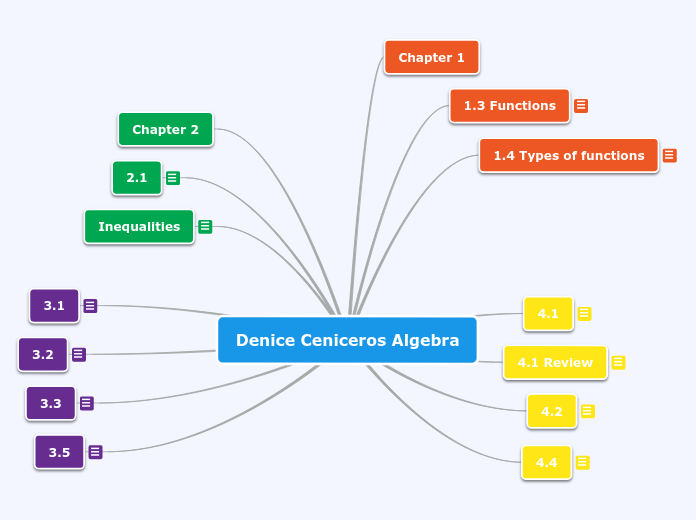Denice Ceniceros Algebra
Chapter 1
1.3 Functions
1.3 Functions and their representationsDefinitions:Variable- a symbol /letter that represents an unknown numberDependent Variable- "y" outputIndependent Variable- "x" inputEquation- two equal algebraic expressionsRelation- comparing at least two things (usually x and y)Function- relation where each input has only one outputy=x^2() Not equal[] Equal to
1.4 Types of functions
Types of FunctionsLinearSymbolic Form- y=mx+b (Slope intercept form)Highest exponent degree is 1.Ex: y=3x+1(Vertical Line)x=2 (a line that is NOT function)(Horizontal Line) y=2 (is a function)Quadratic y=ax^2+bx+cHighest Degree is 2.Ex: y=x^2+2x+11a. f(x)=3x^2+4x+21b. a>02a. a<02b. f(x)=-x^2+2x+1Cubicf(x)=ax^3+bx^2+cx+d(a,b,c,d are constants)Highest exponent is 3.y=x^3 f(x)=6x^3a>0 -- Regular parabolaa<0 -- Upside down parabolaQuarticf(x)=ax^4+bx^cx^2+dx+eDegree is 4.Ex:a>0 --a<0 --Rationalf(x)=a/x-h +kx-h DOES NOT EQUAL 0Ex:f(x)=(3/x+2)Exponentialf(x)=(a)(b^x)(a,b are constants)Ex: a=1 , f(x)=3^3Ex: f(x)= e^x( e is a constant)Ex: a= 1/2 f(x)=1/2(2^x)Logarithmic Absolute Value Functionsf(x)=|x-h|+kEx: f(x)=|x|Average rate of change- (Slope)y2-y1/x2-x1=f(x2)-f(x1)/x2-x1Ex: f(x)=2x^2 (1,3) find average{interval} rate of changef(-2)-f(-3)/-2--3(-3,-2)Difference Quotientf(x-h)-f(x)/(x+h)-x = f(x+h)-f(x)/h Ex: f(t)=-16t^2+16t+32(0,2) -16t^2+16t+32f(0)=32f(2)= 0f(2)-f(0)/2-0 = 0-32/2-0=-32/2=-16
4.1
Non Linear FunctionsSymbolic Form for a polynomialExample: y=mx+b OR f(x)=mx+bF(x)= ax^m+bx^m-1+cx^m-2+. . . .GraphsMin and Max , Absolute Min , Absolute Max , Local Min , Local MaxEnd Behavior - TailsIncreasing/ DecreasingDomain/RangeExample: 2x^3+3x^2+x-1 See DesmosF(x)--> -infinity as x-->- infinityF(x)--> infinity as x--> infinityExample: 2x^3+5x^2+x-2 See DesmosMinimum - (-1.404,-3.557) Maximum - (0.5,0)Increasing: ( Decreasing:Domain: Range:
4.1 Review
Transformations of graphsTranslations/ ReflectionsMinimumMaximumEnd behaviorIncreasing/ Decreasing IntervalsDomain/ RangeEven/ odd functions
4.2
Polynomial Functions and ModelsTurning Point - Point when it goes from increasing to decreasing/decreasing to increasing _Cubic Function_End Behavior - f(x)--> - infin, x --> - infinExample: See note bookIntercepts (x and y intercepts)Example: See notebook x- intercepts (y=0)zerosExample: see notebook and desmosAll interceptsEnd behaviorIncreasing/ Decreasing intervalsConcavity *Concave up / Concave down*3 . Piece wise FunctionsF(x)= {x x>2 Slope=1{2 x<_2 y-int=0^ See notebook{2x x>0{x+2 x<0Project - Compound InterestFV=PV(1+i)^nF+P(1+r)^t#1 and 2# YOU TRY ITF(x)+ax^2+bx+c F(1+r)^2+b(1+r)+c
4.4
Real zeros of higher degree polynomialsExample: f(x)=x^3-61^2+839x+4221 reps aSmall country's bird population , x days after May 31st.Find the date(s) when the population was 5000. Find X when when f(x)= 5000 See NotesFactoring to find zeros f(x)=ax^2+bx+cF(x)= x^2-3x+20=(x-1)(x-2)x-1=0 x-2=0x=1 x=2Zeros with Multiplicity (factored form) GraphExample: f(x)=(x+2)^3 Example: F(x)= (x-4)^3(x+1)=(x+2)(x+2) x=2 =4 Multiplicityx=-1Complete Factored Forma) f(x)= 13x^2 -13x-26 b) f(x)=7x^3-2|x^2-7x+2|GCF = 13 13(x^2-x-2) GCF= 7 (USe grouping method)=13(x-2)(x+1) 7(x^3-3x^2)-(x-3)0=13(x-2)(x+1) x=2 x=-1 7 [(x^3-3x^2)-(x-3)]7[x^2(x-3)-(x-3)]7(x-3)(x^2-1)7(x-3)(x-1)(x+1) X=3,1,-1C) F(x)=2x^3-4x^2-10x+12 (Use Graph)Factoring Continueda) f(x)= 2x^3-2x^2-34x-30 with given zero See NotesIf remainder = 0 ... TRUE FACTORRational Zeros (Not all whole # zeros) Let f(x)=
Chapter 2
2.1
2.1 Linear FunctionsTypes of linesy=mx+b - slope-intercept form Ax+By=C - standard formy-y1=m(x-x1) - point slopeGraphingy=-2x+3Parallel Lines- Have same slope, different Y intercept Perpendicular- slopes are the opposite reciprocalsFind the equation Given...2 points(2,5) (1,0)m= 0-5/1-2= -5/-1 =5y-0= 5(x-1)y=5x-52 . A point and the slopeEx: (3,8) m=4/3y-8= 4/3 (x-3)y= 4/3x +43 . Line parallel to given linesame slope m= -1/2 gos through (0,0)y-0= -1/2 (x-0)y=-1/2x4 . Line perpendicularnegative reciprocal of given slopem= 3/4 m2= -4/3 through (0,-3)y--3= -4/3 (x-0)y+3= -4/3xy=-4/3 x-3
Inequalities
One variable x>_-3x+3x-2<4 --> 4x-2<44x<6 --> x<6/4=3/2 I.N = (-3,infinity)2 . Two variablesGraph to find the solution sety<3x+2 Test Point (-2,3) --> 3<3(-2)+2__ FALSE3 . 2x+3y>_ -4Test point--(0,0) Answer on Desmos4 . Absolute Value|2x|=32x=3 or 2x=-35 . -2 |5x+10|=-4-2/-2|5x+10| =-4/-2|5x+10|<_ 25x+10=2 or 5x+10=-2x<_ -8/5 x>_ -12/5
3.1
CharacteristicsDegree is 2F(x)=ax^2+bx+c (Standard Form)Graph- shape is parabolic (parabola)If a>0, then upwards parabolaIf a<0, then upside down parabolaEx: DesmosD:(-infinity, infinity){x|-infin. <x<infin.} - all real #'sR: [0,inin.)Increasing: (-infin.,0) Decreasing: (0,infin.)4 . Verex Form f(x)=a(x+h)^2+k(h,k) vertexEx: Find the equation given the vertex and a point on the curve.V= (0,3) (2,1)Need to find a and the vertex1=a(2-0)^2+3-2=a(2-0)^2 Answer: f(x)=-1/2(x-0)^2+3-2=a(4) f(x)= -1/2 x^2+3-1/4 =aFind the equation givenV=(-2,4) and (3,6) Answer: F(x)= 2/25(x+2)^26=a(3+2)^2+42=a(5)^22/25=aFind the function form given standard formEx: f(x)=2x^2-4x+1x-coordinate of the vertex is -b/2ay-coordinate F is (-b/2a)Ex: b=4 a=2 x= --4/2(2)=1f(1)= 2(1)^2-4(1)+1= -1 V=(1,-1)
3.2
Quadratic Formulax= -b+- sqrt b^2-4 ac/2aGraphically- X intercepts(2 of these)(1 of these)Analysisthe Discriminant b^2-4acb^2-4ac > 0 2 real solutionsb^2-4ac=0 1 real solutionb^2-4ac <0 2 imaginary solutionsAs long as the equation is of the form ax^2+bx+c=0 , I can use the quadratic formula. Other ways to solveComplete the square when in standard form. (changes to vertex form)Example 1: x^2 -8x +9 =0 1. Move the constant to the other sidex^2 -8x=-9 2. (b/2)^2 (8/2)^2=16(x^2-8x +16)-16 =-9 3. Add and Subtract (b/2)^2(x-4)(x+4)=-9+16Sqrt (x-4)^2 = Sqrt 7 4. Put in vertex formx-4 = +_ sqrt 7 5. Take square root Example 2: x^2 - 8x=7 IN NOTEBOOKExample 3: 3x^2 -6x +z=0When a=/ 1 ...3x^2 - 6x= -23( x^2 -2x ) =-23( x^2 -2x +1 -1)=-23(x^2-2x+1)+3(-1) =23(x-1)^2 = -2+33(x-1)^2 =1(x-1)^2 =1/3x-1=+_ Sqrt 1/3x= 1+_ Sqrt 1/3Factoring when factorable Example: 2x^2 +2x-11=12x=^2+2x-12=02(x^2+x-6)=02(x-2)(x+3)=0 Divide by 2(x-2)(x+3)=0x-2=0 x+3=0x=3 x=-3
3.3
More with imaginary numbersNote: i= Sqrt -1 , i^2=-1If a>0 , then sqrt -a = i sqrt aSimplifyExample: sqrt -16 Example: sqrt -3 X sqrt -3 | isqrt-3 X -isqrt3=i sqrt 16 sqrt 9 | i^2sqr3 Xisqrt3=4i =3WRONG | -1 (3) = -3 RIGHTExample: 2 +_sqrt-24 Example: sqrt -2 X sqrt -82+i sqrt 24 /2 =i sqrt 2 X sqrt 82+isqrt 24 /2 i^2 sqrt 162+i sqrt 4 sqrt -1 (4)=-4i = sqrt -1 i^2=-1treat like a variableExample: i+i=2i Example: 5i-3i=2iExample: 5i X 3i= 15i^2 = 15(-1) =-15Example: 5(-4i)= 20i Example: -6(2i-1)=12i+6Example: 3i/21= 3/2 Example: (2i+1) (2i-1)= 4i^2-2i+2i-1=4i^2 -1=4(-1)-1= -5Complex Conjugates (2-3i)^2 2. -1(5-2i)^2Check NotebookComplex Conjugates3 . 4+i/5-i X 5+i/5+i = 20+5i+4i+i^2/ 25-i^2= 20+9i-1/25+1 = 19+9i/26Complex Numbers and Exponentsi= Sqrt -1 , i^2=-1 , i^3 = i^2 X i =-1 X i =-ii^4 =1 , i^5=i^4 X i =i , i^6= i^4 X i^2= -1i^12= (i^4)^3= 1^3=1 i^50=(i^5)^10= i^10=(i^2)^25=(-1)^25 = -1i^10 2. i^30 3.i^57 3.
3.5
Transformation of a graphGreat auntie- tries to stay near you, go the other direction (parenthesis) Example: (x-4) Go to the right 4, opposite of what you are toldElevator man- wants to get a tip so follows the same direction as in the equationExample: x+5 Go up 5 like the equation says to
